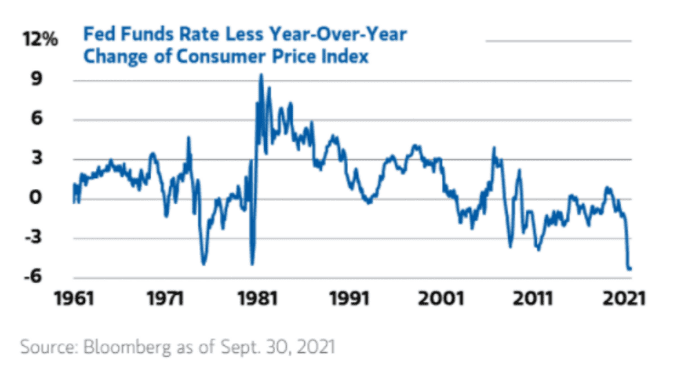‘Risks of a market bubble are growing,’ warns Morgan Stanley
The Federal Reserve’s easy monetary policy and the spike in the pace of inflation have left investors with negative real interest rates, which are fuel for asset bubbles, warned the chief investment officer of Morgan Stanley’s wealth management division.
“All-time low negative real rates are apt to create excesses and poor future returns,” said Lisa Shalett, CIO of Morgan Stanley Wealth Management, in a note Monday. “We are concerned that Fed policy is divorced from the fundamentals.”
Last week Fed Chair Jerome Powell stuck with “a policy of patience” on the timing of raising its benchmark interest rate, she said, describing the outcome of the central bank’s policy meeting as “decidedly dovish, especially given the chair’s ebullient economic outlook.”
Meanwhile, the difference between the fed-funds rate and the consumer-price index, which measures inflation, is the largest ever, the Morgan Stanley Wealth Management note shows. Shalett said “the gap is widest in the 60-year history of the inflation gauge,” known as CPI.

“Risks of a market bubble are growing,” Shalett said. She suggested that investors “watch labor market data, valuations on 2022 forward earnings and fear/greed positioning gauges, which are closing in on extreme overbought conditions.”
Stock-market investors have been “putting stock in the Fed’s patience with interest rate hikes,” according to the note, with the central bank’s timeline for tapering its monthly asset purchases apparently informing that confidence.
“The Fed will reduce monthly $120 billion purchases of US Treasurys by $10 billion a month and $5 billion a month for mortgage-backed securities, signaling its intent to leave interest rates essentially unchanged until June,” Shalett wrote. “Almost on cue, equity investors marked the central bank’s commitment to “lower for longer” rates with yet more new all-time highs, leaving valuations stretched.”
Read: Why markets are like a duck: ‘calm above the surface, but furious churning below’
The U.S. stock market has been hitting a series of all-time highs in an extraordinary run during the pandemic. The S&P 500 SPX,
“Stocks continue to be stoked by excess liquidity and the Fed’s dovish rhetoric about rate hikes,” Shalett wrote. It’s “a dynamic that rewards devotion to passive investing in the S&P 500 index” and its highly-valued largest constituents, “which depend on a low-rate regime.”
“Negative real rates bolster long-duration and growth-oriented assets,” she said, “but contribute to asset bubbles and the misallocation of capital.”



